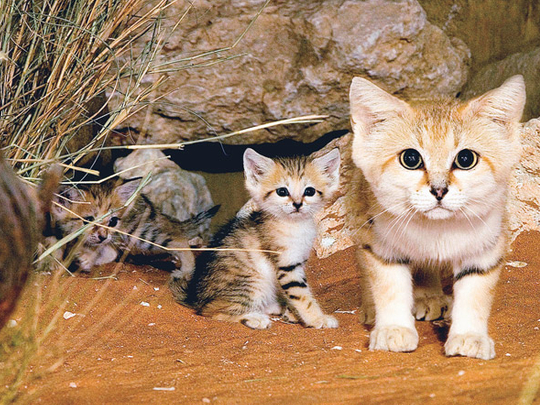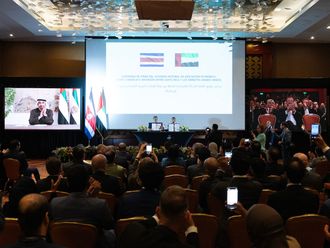
Al Ain: Two sand cat kittens have been born in Al Ain.
The mother and litter are in good health in the Al Ain Wildlife Park and Resort (AWPR) but the sex of the kittens are yet to be ascertained.
The litter was produced by in-vitro fertilisation and embryo transfer at AWPR, which is home to almost 20 per cent of the world's captive sand cats.
The 34 sand cats at AWPR make up the largest and most genetically significant captive population of sand cats in any zoological institution.
AWPR initiated Project Sand Cat in partnership with the US-based University of Illinois and the Cincinnati Zoo and Botanical Garden, two top institutions engaged in endangered species research, in October.
Fresh sperms and eggs collected from sand cats were fertilised in an incubator to produce 50 embryos. Twenty-one embryos were transferred into host cats, one of which became pregnant.
The remaining embryos were frozen and transported to the Cincinnati Zoo for similar trials.
Protocols
"No sand cat kitten has ever been born as a result of in-vitro fertilisation and embryo transfer. Our sand cat mother gave birth to two kittens. The kittens and mother are in a very good condition," said Farshid Merhdadfar, the Animal Collection Manager at AWPR.
According to Dr Mike Maunder, AWPR's Chief Programmes Officer, the goal is to develop protocols for embryo transfer that can be used for sand cat and other more threatened species
such as the Arabian leopard. "This technique will allow sand cats, and other threatened species, held in the UAE to contribute to the breeding work of conservations institutions throughout the world," he said.
The in-vitro fertilisation and embryo transfers would not be possible without AWPR's large number of sand cats. Eggs were harvested from five female donors, fertilised with the sperm from three male sand cats, and the resulting embryos were implanted in a separate group of four female recipients.
Embryo transfer is an important technology for conservation efforts. Embryos fertilised at AWPR can be frozen and later implanted into recipient groups across the world.
"We can exchange genetic material without having to transport the animals themselves. This is a model in managing threatened wildlife species in the future," said Dr Bill Swanson, Director of Research at the Cincinnati Zoo.
Viable population
According to Dr Swanson, the cats at AWPR are totally unrelated to other sand cats held anywhere in captivity. "To introduce their genetic material to other populations helps build a stronger and more viable captive population."
This process diversifies the gene pool of captive Sand cat populations. One such trial of the embryos fertilised at AWPR is underway at the Living Desert Zoo in California.
Project Sand Cat is a pilot project within AWPR's conservation programme.
The AWPR focuses on the conservation and restoration of arid land biodiversity and has a special focus on desert carnivores including current work with Arabian leopards, African wild dogs, and African lions.
What are sand cats?
The Sand cat (Felis margarita), also referred to as the sand dune cat, is a small wild cat distributed over African and Asian deserts. It is listed as Near Threatened due to concern over potential low population size and decline. It lives for about 13 years in captivity.
The Sand cat's length averages almost 50cm with a 30cm tail. The average weight of a sand cat is 2.7kg. Their heads are conspicuously broad, and their ears are large, pointed, and widely spaced to the point they can be flattened horizontally or even pointing down to help when hunting.
Their paws are covered with long hairs that allow it to tolerate and easily manoeuvre the hot sand of its environment. The sand cat can survive in temperatures ranging from −5°C to 52°C.












